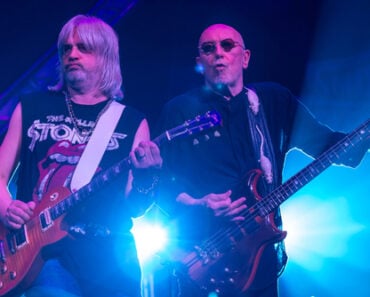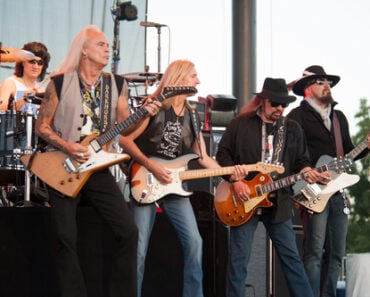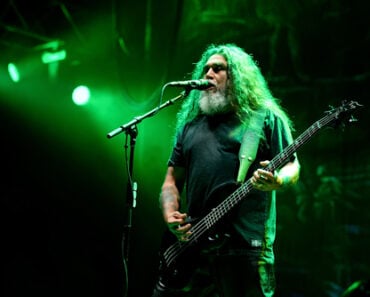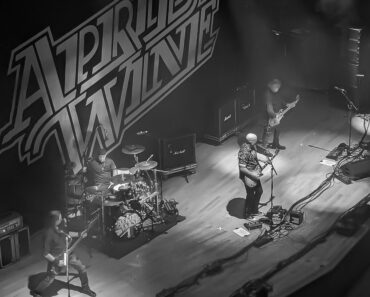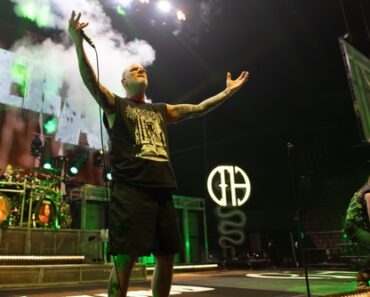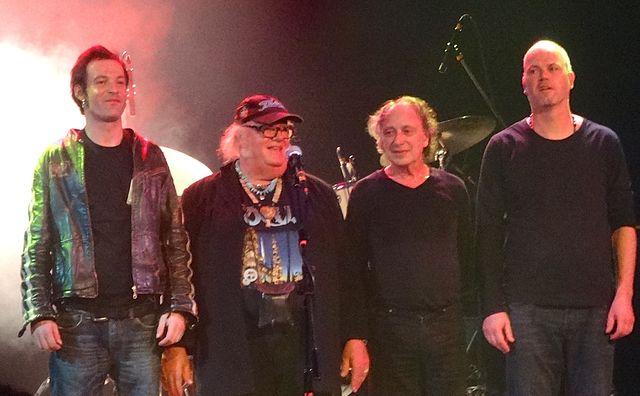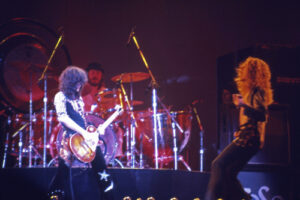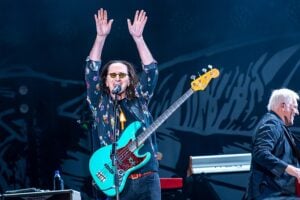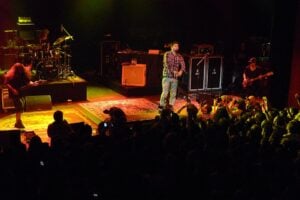
Feature Photo: Michael Borkson, CC BY-SA 2.0 <https://creativecommons.org/licenses/by-sa/2.0>, via Wikimedia Commons
Hot Tuna stands as one of America’s most enduring blues rock institutions, born from the creative restlessness of two Jefferson Airplane veterans who yearned to explore deeper musical roots. Formed in 1969 by guitarist Jorma Kaukonen and bassist Jack Casady, the band emerged during a hiatus in Jefferson Airplane activities when Grace Slick was recovering from vocal cord surgery. Their debut album peaked at #30 on the Billboard 200 album chart, establishing them as a viable commercial entity separate from their parent band. Over their 55-year career, Hot Tuna has released 7 studio albums and 14 live albums, with their discography spanning over two dozen records when including compilations and special releases.
Hot Tuna has always been a fluid aggregation, with musicians coming and going over the years, though the band’s center has always been Kaukonen and Casady’s ongoing collaboration. The band experienced several distinct phases, from their acoustic blues origins through their mid-1970s “metal period” to their 1980s reunions and continuing evolution. All but two Hot Tuna albums from their classic era reached the Billboard Top 100, with America’s Choice being their only post-1972 album to chart for more than ten weeks, peaking at No. 75. While they never achieved massive commercial success with radio singles, America’s Choice produced a minor hit single in “Hit Single #1”, and their reputation was built primarily on their legendary live performances and devoted cult following.
As members of the Rock & Roll Hall of Fame and Grammy recipients through their Jefferson Airplane connection, Kaukonen and Casady helped shape the musical landscape of their era. Jorma’s Blue Country Heart was nominated for a Grammy Award, demonstrating the continuing recognition of their musical contributions. In October 2022, Jefferson Airplane received its star on the Hollywood Walk of Fame, with surviving members Casady, Kaukonen, and Grace Slick attending the ceremony. Despite personnel changes and temporary hiatuses, Hot Tuna never officially disbanded, continuing to tour and record into the 2020s with their core duo intact.
Jorma Kaukonen
Jorma Ludwik Kaukonen Jr. was born on December 23, 1940, in Washington, D.C., to parents with Finnish paternal grandparents and Russian Jewish ancestry on his mother’s side. As Hot Tuna’s founding guitarist and primary vocalist, Kaukonen has remained the band’s musical and creative driving force throughout their entire history. Rolling Stone magazine ranked him No. 54 on its list of “100 Greatest Guitarists,” and he was inducted into the Rock and Roll Hall of Fame in 1996 as a member of Jefferson Airplane. His distinctive fingerpicking style, heavily influenced by Reverend Gary Davis, became Hot Tuna’s signature sound and distinguished their acoustic performances from typical electric blues rock.
Kaukonen appeared on every Hot Tuna album from their 1970 debut through their most recent releases. His guitar work was featured prominently on the semi-acoustic debut album, which showcased his Piedmont-style acoustic blues fingerpicking skills. By the time of The Phosphorescent Rat (1973), Kaukonen was at the peak of his songwriting, with the album showcasing mostly his original compositions. Beginning with America’s Choice (1974), his lyrics took on a more quasimystical quality as the band evolved into their heavy rock phase. During Hot Tuna’s hiatus period, he released solo albums including Quah (1974) and experimented with a punk image in the early 1980s with albums like Barbeque King.
Beyond Hot Tuna, Kaukonen has maintained an active solo career and established himself as an educator and preservationist of American roots music. With his wife Vanessa, Kaukonen currently owns and operates the Fur Peace Ranch, a 119-acre music and guitar camp in the hills of southeast Ohio, complete with a 32-track studio. He has released many solo albums over the years, including two highly acclaimed releases on Red House Records. His 2018 autobiography “Been So Long: My Life and Music” provides insights into his musical journey and Hot Tuna’s history. At almost 85 years of age, Kaukonen remains at the apex of his skills, captivating audiences with his husky voice and proficient blues licks.
Jack Casady
Jack Casady has served as Hot Tuna’s bassist and co-founder since the band’s inception in 1969, providing the rhythmic foundation that has anchored their sound across all musical phases. Growing up in the Washington D.C. area where his father was a dentist, Jack played professional gigs as lead guitarist at night before he was old enough to drive. Casady is considered one of rock’s first bass heroes and one of today’s most innovative electric bass players, having also played with such legends as Ray Charles, Jimi Hendrix and the Grateful Dead. His innovative approach to the bass guitar transformed the instrument from a purely rhythmic role to a lead voice in Hot Tuna’s arrangements.
Casady appeared on every Hot Tuna recording, adapting his style to match the band’s evolution from acoustic folk-blues to heavy electric rock. On their debut album, he played electric bass even in the semi-acoustic configuration, providing a unique foundation for Kaukonen’s fingerpicking style. His creativity is evidenced by his continually evolving bass solos in his extensive library of songs and live performances. During the band’s heavy rock period of the mid-1970s, his bass work became more aggressive and prominent in the mix, contributing to their “rampage” style. During Hot Tuna’s late-1970s hiatus, Casady formed the new wave band SVT, demonstrating his versatility across musical genres.
Jack released his first solo CD, Dream Factor, on Eagle Records in 2003, showcasing his abilities as a bandleader and composer. Throughout Hot Tuna’s various reunions and reformations, Casady remained committed to the partnership with Kaukonen that has defined both their careers. His bass innovations influenced countless musicians and helped establish the template for rock bass playing that emerged in the late 1960s and early 1970s. Now in his 80s, Casady continues to tour and record, maintaining the high standards of musicianship that have characterized Hot Tuna throughout their career.
Papa John Creach
Violinist Papa John Creach joined Hot Tuna and Jefferson Airplane in October 1970, becoming a full-time member of both bands. His addition marked Hot Tuna’s transition from their primarily acoustic debut to a fuller electric band sound. This lineup of Kaukonen, Casady, drummer Sammy Piazza, and Creach was first documented on the album First Pull Up, Then Pull Down (1971). Creach brought a unique folk-rock violin style that complemented Kaukonen’s guitar work and added a distinctive voice to Hot Tuna’s evolving sound. The albums First Pull Up, Then Pull Down (1971) and Burgers (1972) showed development to a fuller but less blues-based sound and featured Creach on violin.
Creach’s contributions to Hot Tuna included both studio recordings and extensive touring during their early electric period. The group also appeared on three tracks from Papa John Creach’s debut solo album, as well as “Walking the Tou Tou” from his second album, Filthy! His violin work provided melodic counterpoint to Kaukonen’s increasingly complex guitar arrangements and helped establish Hot Tuna as more than just a conventional blues-rock power trio. Creach left before The Phosphorescent Rat was recorded in 1974, ending his three-year tenure with the band during a crucial developmental period.
Papa John Creach died in 1994, but his influence on Hot Tuna’s sound during their formative electric years remained significant. His violin work on albums like Burgers demonstrated how traditional folk and country instruments could be integrated into blues-rock arrangements without losing their essential character. Beyond Hot Tuna, Creach maintained a successful solo career and continued his work with Jefferson Airplane/Jefferson Starship. His period with Hot Tuna represented one of the few successful integrations of violin into blues-rock music, predating similar experiments by other major rock acts.
Will Scarlett
Born in New Hampshire in 1948 and raised since the age of 2 in Berkeley, California, Will Scarlett became Hot Tuna’s harmonica player during their earliest acoustic period. Returning to the Bay Area, Will was asked by Jorma Kaukonen to play and record with him and Jack Casady during twelve consecutive shows at New Orleans House in Berkeley. Some tracks on their debut album included Will Scarlett on harmonica, and his harmonica graces the first two Hot Tuna albums, where he can be heard overblowing a single G Hohner Navy Band harmonica in all keys. His innovative approach to the harmonica expanded the instrument’s range and capabilities within blues-rock contexts.
Scarlett’s musical career took off in 1966 when he hooked up with other musicians to form the Cleanliness (is Next to) Godliness Skiffle Band, serving as the house band for the legendary Jabberwock Club in Berkeley. In 1968, Scarlett accompanied Brownie McGhee on a six-week tour of eastern Canada, filling in for the ailing Sonny Terry. This experience with traditional blues masters informed his approach to harmonica playing and brought authenticity to Hot Tuna’s early acoustic sound. Will Scarlett performed with Hot Tuna from 1969 to 1971, covering their transition from pure acoustic performances to their first electric experiments.
Beyond Hot Tuna, Scarlett recorded with numerous notable artists including Dave Bromberg, Old and in the Way, David Grisman, and Jerry Garcia. His work with the bluegrass supergroup Old and in the Way showcased his versatility across American roots music genres. He has performed with Zydeco accordion players Clifton Chenier, Andre Carriere, Andre Thierry, and Buckwheat Zydeco, demonstrating his ability to adapt his harmonica style to diverse musical traditions. Today, Will teaches harmonica by appointment, records with a variety of musicians, and performs throughout the Bay Area, continuing to influence new generations of harmonica players.
Joey Covington
Joey Covington, a self-taught drummer since the age of 10, helped found Blues-rock group Hot Tuna in 1969, alongside Jefferson Airplane members Jack Casady and Jorma Kaukonen. Kaukonen, Jack Casady, Paul Kantner and new drummer Joey Covington played several shows around San Francisco, including the Airplane’s original club, The Matrix, before Jefferson Airplane resumed performing. By the time of their debut album, they had added harmonica player Will Scarlett, drummer Joey Covington and guitarist Paul Ziegler. Covington’s drumming provided the rhythmic foundation for Hot Tuna’s early performances and helped establish their reputation as a live act.
However, the recordings he did for Tuna were unreleased and he eventually rejoined Casady and Kaukonen at Jefferson Airplane. Joey Covington performed drums with Hot Tuna from 1969-1970 before transitioning back to Jefferson Airplane full-time. He featured on three Jefferson Airplane studio albums, the first being Volunteers, as he replaced Spencer Dryden midway through the recording process. He wrote and sang the last hit for Jefferson Airplane, 1971’s “Pretty As You Feel” featured on the Bark Album. His brief tenure with Hot Tuna coincided with their most experimental early period, when the band was still defining its musical direction.
Covington left Jefferson Airplane in mid-1972 to pursue a solo career, starting with Fat Fandango. He subsequently faded from view, only resurfacing sporadically, like in 1976’s Spitfire by Jefferson Starship, where he co-wrote the hit single “With Your Love”. Joey Covington died in 2013, ending a career that bridged the gap between Hot Tuna’s formation and Jefferson Airplane’s continued evolution. His contributions to Hot Tuna’s early development, though brief, helped establish the band’s identity during their crucial formative period when they were transitioning from being merely a Jefferson Airplane side project to an independent musical entity.
Sammy Piazza
Drummer Sammy Piazza joined Hot Tuna along with Papa John Creach as the band moved fully to the electric band format in the early 1970s. This lineup was first documented on the album First Pull Up, Then Pull Down (1971), which was recorded live at the Chateau Liberte. Piazza played drums on First Pull Up, Then Pull Down (1971) and Burgers (1972), both of which showed development to a fuller but less blues-based sound. The studio albums Burgers (1972) and The Phosphorescent Rat (1974) followed, with Creach leaving before the latter was recorded, but as the band prepared for its 1974 tour in support of The Phosphorescent Rat, Kaukonen laid off Piazza after deciding to have the band return to its semi-acoustic repertoire.
Sammy Piazza performed drums with Hot Tuna from 1970-1973, covering the crucial period when the band transitioned from acoustic folk-blues to full electric rock arrangements. His drumming style adapted to Hot Tuna’s evolving sound, providing steady rhythmic support for Kaukonen’s increasingly complex guitar work and Casady’s innovative bass lines. The album The Phosphorescent Rat was recorded at Wally Heider Studios in San Francisco with the band featuring Jorma Kaukonen on guitar and vocals, Jack Casady on bass, and Sammy Piazza on drums. His work on this album helped establish the template for Hot Tuna’s later heavy rock period.
Piazza’s departure marked the end of Hot Tuna’s first electric phase and preceded their evolution into the power trio format that would define their mid-1970s peak. Piazza appeared on various Hot Tuna compilation albums including Final Vinyl and historic releases, cementing his place in the band’s recorded legacy. His drumming contributions during Hot Tuna’s early electric years provided the foundation for their later commercial success and helped bridge the gap between their acoustic origins and their later heavy rock incarnation. While his tenure was relatively brief, Piazza’s work during this crucial developmental period helped establish Hot Tuna as a serious electric blues-rock band capable of standing apart from Jefferson Airplane.
Bob Steeler
Beginning with their fifth album, America’s Choice (1974), the addition of drummer Bob Steeler encouraged a rise in volume and a change of band personality—a rampaging, Cream-like rock with often quasimystical lyrics by Kaukonen. For America’s Choice and the next three albums, Bob Steeler filled the drum seat, marking the era known to fans as Tuna’s “metal period”. Bob Steeler performed drums with Hot Tuna from 1974-1977, covering their most commercially successful period and their evolution into a heavy rock power trio. His powerful drumming style perfectly complemented the band’s new direction toward maximum volume and extended improvisational jams.
His “rampage” style is typified by the solos on “Funky #7” and “Serpent of Dreams” on America’s Choice and “Song for the Fire Maiden,” “Sunrise Dance with the Devil,” and “Surphase Tension” on Yellow Fever. Live performances throughout this epoch were distinguished by free-flow improvisational jams and very long sets (up to six hours uninterrupted) with extended versions of their studio material. Steeler’s drumming provided the foundation for these marathon performances, maintaining energy and momentum through extended instrumental explorations. A November 1976 concert at the Palladium in New York City featured a 16-minute version of “Invitation”, showcasing the trio’s ability to stretch songs far beyond their studio versions.
The trio stopped touring at the end of 1977 and performed its final concert at the Palladium on November 26, with keyboardist Nick Buck and saxophonist “Buffalo” Bob Roberts. After Hot Tuna’s breakup in 1978, Bob Steeler initially joined Kaukonen’s touring combinations, first known as “Hidden Klitz,” then as “White Gland,” and finally as “Vital Parts”. His work with Hot Tuna during their heaviest period established him as one of the premier blues-rock drummers of the 1970s. Steeler appeared on the live album Double Dose and numerous compilation releases, documenting his contributions to Hot Tuna’s most intense musical period. His powerful, aggressive drumming style became synonymous with Hot Tuna’s peak commercial period and influenced many subsequent blues-rock drummers.
Michael Falzarano
Michael Falzarano is an American guitarist, singer, and songwriter who has been a professional musician since the 1970s, most notably in Hot Tuna, the New Riders of the Purple Sage, and the Memphis Pilgrims. Rhythm guitarist Michael Falzarano and drummer Shigemi Komiyama joined Kaukonen and Casady for a Hot Tuna reunion tour in 1983. Michael Falzarano performed rhythm guitar with Hot Tuna during 1983, and later from 1989-2002, making him one of the longest-serving non-founding members in the band’s history. His guitar work and songwriting contributions helped define Hot Tuna’s sound during their reunion years and provided crucial support for Kaukonen’s lead guitar work.
Throughout the 1990s, Hot Tuna again alternated between acoustic and electric styles. The two Sweetwater albums were predominantly acoustic sets with guests such as Bob Weir, Maria Muldaur and former Jefferson Starship bassist-keyboardist Pete Sears. Shortly thereafter, New Yorker Harvey Sorgen replaced Stefko on drums and Galen Underwood joined on keyboards for their first album of all new material in almost 14 years, 1990’s Pair a Dice Found. Kaukonen and Falzarano both contributed original songs. His songwriting abilities added new dimensions to Hot Tuna’s repertoire and helped modernize their sound for new audiences. Falzarano handled vocals on several songs, most notably on “Gypsy Fire,” which was described as perhaps the best song that Hot Tuna performed.
Falzarano also produces other artists, and teaches guitar workshops at Jorma Kaukonen’s Fur Peace Ranch. His original composition “When There’s Two There’s Trouble” was featured in Alexandre Moors’ critically acclaimed film Blue Caprice and appeared on Jorma Kaukonen’s 2015 Red House release “Ain’t In No Hurry”. He founded the Memphis Pilgrims, a Memphis-style rock and roll/blues band, in 1986 and has released several solo albums including We Are All One in 2008 and The King James Sessions in 2005. His versatility across multiple projects demonstrates his importance as a collaborator and his ability to adapt to different musical contexts while maintaining his distinctive style and approach to guitar and songwriting.
Pete Sears
From 1992 to 2001, Sears played keyboards with Jefferson Airplane’s Jorma Kaukonen and Jack Casady in Hot Tuna. The band also included Michael Falzarano and Harvey Sorgen. Pete Sears performed keyboards with Hot Tuna from 1992-2001, providing the band with its first regular keyboardist since Nick Buck’s contributions in the 1970s. They would sometimes tour as “The Jorma Kaukonen Trio” with Sears playing piano and accordion adding bass on the keyboards with his left hand. His keyboard work added new textures to Hot Tuna’s sound and helped distinguish their 1990s incarnation from their earlier purely guitar-bass-drums format.
Sears joined the band Jefferson Starship in 1974 and remained with the group through the transition to Starship, before departing in 1987. His experience with Jefferson Starship provided valuable connections to the extended Jefferson Airplane family and brought professional studio and touring experience to Hot Tuna’s reunion years. Keyboardist Pete Sears provided subtle keyboard accompaniments and swirling solos during Hot Tuna’s performances, enhancing their live sound with tasteful additions that never overwhelmed the core guitar-bass foundation. Sears appeared on numerous Hot Tuna recordings during the 1990s, including Live at Sweetwater and Live at Sweetwater Two.
Sears has played with many other musicians through the years, including Dr. John, John Lee Hooker, Jerry Garcia, Chris Robinson Brotherhood, Levon Helm, Steve Kimock, and Phil Lesh. In 2011, Hot Tuna flew Sears out to New York City to perform at Jorma Kaukonen’s 70th birthday bash at the Beacon Theatre, joining Bob Weir, Steve Earle, and Oteil Burbridge. His extensive résumé and connections within the jam band and blues rock communities helped Hot Tuna maintain relevance during their 1990s touring years. Sears sometimes teaches piano or bass at Jorma Kaukonen’s Fur Peace Ranch guitar camp in southeastern Ohio, continuing his educational role within the Hot Tuna extended family even after his departure from regular touring duties.
Barry Mitterhoff
For the last few years, Jorma and Jack have been joined in most of their Hot Tuna performances by the mandolin virtuoso Barry Mitterhoff. Barry Mitterhoff performed mandolin with Hot Tuna from 2002-2014, bringing a new instrumental voice to the band’s acoustic performances and helping them explore bluegrass and folk influences more deeply. A veteran of bluegrass, Celtic, folk, and rock-influenced bands including Tony Trischka and Skyline, Hazel Dickens and Bottle Hill, Barry has found a new voice in working with Hot Tuna, and the fit has been good. His mandolin work provided melodic counterpoint to Kaukonen’s guitar and added textural variety to their acoustic sets.
Watching them play together, it’s as if he’s been there from the beginning. In addition to rounding out their acoustic sound, Barry brings out a wide array of electric mandolins and similar instruments that most people have probably never seen or heard before. Barry Mitterhoff was described as “a guy who shreds & bends mandolin strings like a metal guitarist; he brought another strong instrumental voice to every song he played”. His virtuosic approach to the mandolin expanded its traditional role in folk and bluegrass music, adapting the instrument to Hot Tuna’s blues-rock context. In 2004, Casady and Kaukonen were joined by mandolinist Barry Mitterhoff and drummer Erik Diaz.
Mitterhoff appeared on Michael Falzarano’s recordings, including “Death Don’t Have No Mercy” where he provided excellent mandolin work alongside Jason Crosby’s fiddle. His collaborations with other Hot Tuna members on side projects demonstrated his versatility and commitment to the extended Hot Tuna musical community. In November 2010, Hot Tuna performed as a semi-acoustic trio: Casady, Kaukonen and Mitterhoff at a Midnight Ramble at Levon Helm’s Barn studio in Woodstock, New York. His departure in 2014 marked the end of an era when Hot Tuna regularly featured mandolin as a prominent voice in their arrangements, though his influence on their acoustic approach continues to resonate in their current performances.
Skoota Warner
The newest member of Hot Tuna is the brilliant and exciting young drummer Skoota Warner, who already had a career few would dare aspire to when he joined the band in 2009. In August 2009, following the departure of Diaz, Skoota Warner officially joined the band as drummer. Like many in the blues-inspired music world, his musical life began in church, in his hometown of Newnan, Georgia. Skoota Warner performed drums with Hot Tuna from 2009-2014, bringing youthful energy and modern drumming techniques to the veteran blues-rock band. His playing was described as crisp, and he seemed to add a new layer of energy to the ensemble.
Warner’s tenure with Hot Tuna coincided with some of their most significant recent achievements, including their first studio album in twenty years. In the same month he joined, Kaukonen announced on his blog that Hot Tuna had begun recording its first studio album in 20 years. The album, Steady as She Goes, was released by Red House Records on April 5, 2011. His drumming on this album helped establish Hot Tuna’s contemporary sound and demonstrated their ability to remain relevant in the modern music landscape. Recent performances featured Jorma Kaukonen and his Hot Tuna bandmates Jack Casady and Justin Guip, indicating that Warner had departed by the time of these later concerts.
Check out more Hot Tuna articles on ClassicRockHistory.com Just click on any of the links below……
Top 10 Hot Tuna Songs
Complete List Of Hot Tuna Albums And Discography
Read More: Artists’ Interviews Directory At ClassicRockHistory.com
Read More: Classic Rock Bands List And Directory


